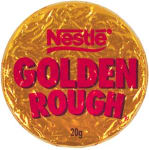I am such a sucker for a pretty package.
At least, when it comes to omiyage, what's inside is usually pretty good, too. I've noticed quite a lot of omiyage packaging has gone kind of Taisho-era recently. I remember years ago in Sydney, I saw an exhibition called "Taisho Chic" or something. It was all about the Moga - Modern Girls - with Louise Brooks style bobs, who smoked cigarettes, went to cafes and listened to Jazz. Yes, Japan had flappers too. Like England's Edwardian era, Taisho was quite short (1912 - 1926), but it was a time of creativity and democracy, which unfortunately got taken over by militarism and... well, a lot of big problems that are still festering today.
Anyway, what's important here, is that it inspired some lovely Deco style design. Sometimes, you can still find examples Taisho-era architecture, though they're rare. Kawagoe has a nice mix of Meiji-style, Taisho and early Showa buildings. Tokyo's Imperial Hotel, by Frank Lloyd Wright, even survived (but was damaged in) the Great Kanto Earthquake of 1923 and WWII. Part of it has now been reassembled in Meiji Mura near Nagoya. I hope I can see it there one day. The Old Imperial Bar in Tokyo, while not original, is in the style of the time. I'm always on the lookout for Taisho-era or at least Taisho-style places.
 |
| "Tipsy" by Kobayakawa Kiyoshi |
Ok, so on to the food! First up, Shiseido Parlour. Originally a soda fountain attached to the Shiseido Pharmacy in 1902, it became a cafe and purveyor of sweets and oddly, one of the first places to serve western-style dishes like croquettes (korroke). So it's 110 years old this year - as good an excuse as any to visit. The famous cinnabar red building in Ginza houses the sweets on the ground floor, and a cafe, restaurant and function spaces upstairs.
This is a limited edition for Autumn: chestnut flavoured cheese cake. The package is really lovely; a mix of gloss and matte black, and though you can't really see it in the photo, the chestnuts are printed in bronze. The use of the branches to frame the name reminds me of those Arts & Crafts style houses in California. Then inside, you get three miniature cheese cakes, which are really light and 'cakey'. Inside, you'll find smooth, sweet chestnut paste. The flavours work well together. They smell amazing, too - surprisingly 'home made'. They demand strong coffee. About 650Yen for 3 (you can get bigger boxes, but there's that temptation to eat them all and not share!)
 |
Must have been a very expensive printing job - you can't really see here, but it's a mix of matte and gloss black, plus metallic.
|
 |
| Three little boxes inside and three exquisite cheese cakes. |
Next, the beautiful simplicity of Higashiya. If you've been to the Higashiya cafe in Ginza (in the Pola Building), you'll know they make an art form of simplicity.
 |
| This is the entrance |
 |
| Inside the cafe |
 |
Very simple - the most delicious shiomusubi (all I could afford that day, actually!) and some yuzu green tea.
|
If you can't get to their cafe, try "Higashiyaman" in Aoyama - just around the corner from Issey Miyake - and you can get fresh sweets to take away. This tin, in black and white, mirrors the brand's logo. Inside, you'll find delicate, crispy rice treats called okoshi. These ones are flavoured with ginger.
 |
| It's the kind of tin you'll keep for a long time after the sweets are finished. |
 |
The shopping bag.
|
Next, we detour to Hokkaido on our packaging tour, and a little earlier - to the Meiji era. I had heard of the Sapporo Agricultural College before - apparently in the 1880s they had one of the most successful English programs, using language immersion. It became Hokkaido University in 1918, but the Agricultural part still functions as a faculty. And they make amazing cookies! These are light, crispy, buttery shortbread cookies. Well, actually, they don't make the cookies themselves. A Sapporo sweets company called Kinotoya make these "just like grandma's but fancier" cookies, for the university. They started making them in 2005, and inside the box, you'll find the phrase "Boys be ambitious" (nearly typed ambiguous, which might be more appropriate these days). It's the famous catch phrase of 1880s Hokkaido University professor Dr William Clark. It's nice to know that some of the profits from the cookies will go to the university's greenery program.
 |
Retro design, based on the original logo of the University.
|
And finally, something quite new, but in the spirit of the era. This is another limited seasonal design, using a motif of ginko leaves. Wa.bi.sa is an offshoot of confectioner Yoku Moku (you have to visit their amazing "Blue Brick Lounge" in Aoyama - not just sweets! It's very ladies-who-lunch). Anyway, the company is famous for its light, European-style chocolates and biscuits. But what's interesting in a random way, is the name Yoku Moku comes from the Swedish town of Jokkmokk in northern Sweden. Wa.bi.sa (from wabisabi meaning refinement and simplicity in that very zen Japanese way), is their younger, funkier brand, combining traditional Japanese flavours with modern design. I like the transitions of colours on this package, with stylised ginko leaves. Inside, the cookies - a kind of 'karinto' or fried cookie - are green tea flavour and shaped like sakura flowers.
 |
| This is what the cookies inside look like - minus the ribbons. |














































